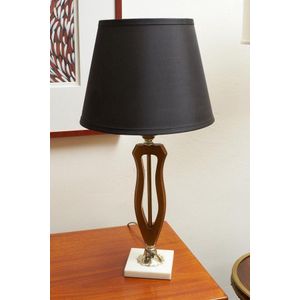Walnut Sewing Table with Chess Board Inlay
You must be a subscriber, and be logged in to view price and dealer details.
Subscribe Now to view actual auction price for this item
When you subscribe, you have the option of setting the currency in which to display prices to $Au, $US, $NZ or Stg.
- Parquetry - Parquetry is inlay laid in geometric patterns, the contrast being achieved by the opposing angles of the grain and veneers. The herringbone pattern is the most commonly used in flooring, but this is almost never seen in furniture - the patterns used are more complex and unlike flooring, can include several different varieties of timber.
- Inlay - Decorative patterns inserted into the main body of a piece of furniture, generally in wood of contrasting colour and grain, though brass, ivory, ebony, shell and sometimes horn have been used. Inlay may consist of a panel of well figured timber inset into a cabinet door front, geometric patterns, or complex and stylized designs of flowers, swags of foliage, fruits and other motifs. As a general rule, in pieces where the carcase is constructed in the solid, the inlay is relatively simple such as stringing, cross banding and herringbone banding. Where more elaborate and decorative work was required veneer was used. Inlay has been fashionable from at least the latter half of the 17th century, when a variety of elaborate forms were developed
- Victorian Period - The Victorian period of furniture and decorative arts design covers the reign of Queen Victoria from 1837 to 1901. There was not one dominant style of furniture in the Victorian period. Designers used and modified many historical styles such as Gothic, Tudor, Elizabethan, English Rococo, Neoclassical and others, although use of some styles, such as English Rococo and Gothic tended to dominate the furniture manufacture of the period.
The Victorian period was preceded by the Regency and William IV periods, and followed by the Edwardian period, named for Edward VII (1841 ? 1910) who was King of the United Kingdom and the British Dominions and Emperor of India for the brief period from 1901 until his death in 1910.
This item has been included into following indexes:
-
tables, purpose or type
- chess 248
- sewing and work 357
Visually similar items

A Victorian mahogany, drop-side chess table, by James Burrey, Shrewsbury, the top inlaid with rosewood and satinwood chequer board squares, upon a turned pedestal and carved cabriole leg base, the table has two single drawers; one containing a makers label

A Pakistani Bokhara Turkoman carpet, a soft textured rug in a traditional allover jaldar design, in muted chalky pastel hues upon a soft mushroom field, length 423 cm, width 314 cm

A pair of mid-century American bedside lamps, sculptured form on marble base, fully rewired, 60 cm high, 30 cm deep

An antique 17th century style oak footstool, covered in green and red tartan fabric, 45 cm high, 40 cm wide. Provenance: John Dunn Antiques, Melbourne
